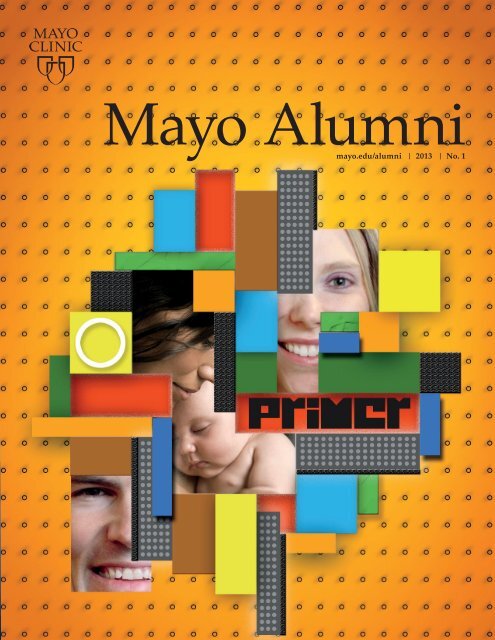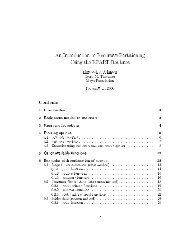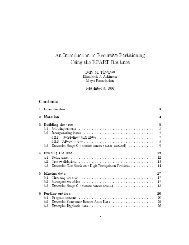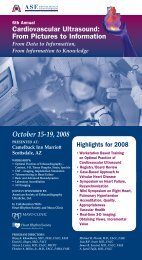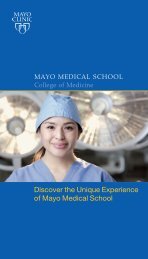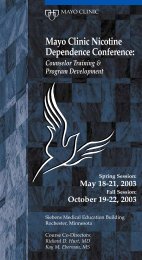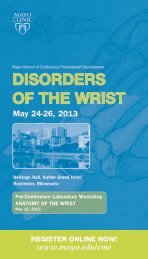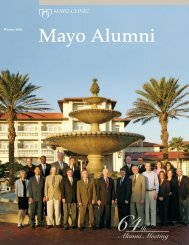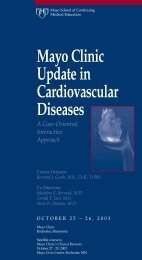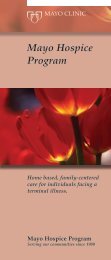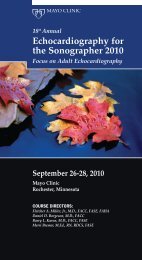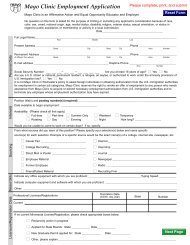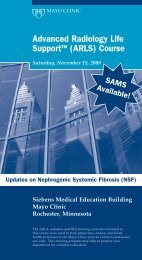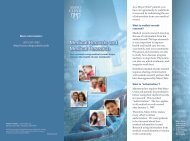current issue - Mayo Clinic
current issue - Mayo Clinic
current issue - Mayo Clinic
You also want an ePaper? Increase the reach of your titles
YUMPU automatically turns print PDFs into web optimized ePapers that Google loves.
<strong>Mayo</strong> Alumni<br />
mayo.edu/alumni | 2013 | No. 1
<strong>Mayo</strong> Alumni<br />
2013 | No. 1<br />
Features<br />
2 Jerusalem international program<br />
Traveling abroad and bringing home the lessons learned is a continuation<br />
of the <strong>Mayo</strong> brothers’ work.<br />
4 PRIMER OB/GYN ‘boot camp’<br />
First-year obstetrics/gynecology and family medicine residents train<br />
in the <strong>Mayo</strong> <strong>Clinic</strong> Multidisciplinary Simulation Center to master procedural<br />
skills in the innovative PRIMER program developed by Brian Brost, M.D.<br />
14 Balfour/Kendall awardees — Where are they now?<br />
Recipients of these awards through the years have attained successful<br />
academic careers and headed significant research laboratories. <strong>Mayo</strong> Alumni<br />
catches up with William J. Martin II, M.D., and Fernando Azpiroz, M.D., Ph.D.<br />
About the Cover<br />
<strong>Mayo</strong> <strong>Clinic</strong>’s innovative PRIMER (Procedural<br />
Repetition Involving Montessori-type<br />
Experience and Rehearsal) program<br />
focuses on preparing first-year obstetrics/<br />
gynecology and family medicine residents.<br />
Two full weeks are devoted to mastering<br />
procedural skills through repetition in the<br />
Multidisciplinary Simulation Center (SIM<br />
Center), with learners receiving continuous<br />
constructive feedback. Brian Brost, M.D.,<br />
a consultant in the Department of Obstetrics<br />
and Gynecology and operations director<br />
for the SIM Center, conceived the program<br />
in 2007. According to Bobbie Gostout,<br />
M.D., chair of the Department of Obstetrics<br />
and Gynecology, the program is a tool to<br />
make learners better for patients, based<br />
on <strong>Mayo</strong>’s primary value of patients coming<br />
first. “It’s an alternate model to practicing on<br />
real people,” she says. “Leaders throughout<br />
our institution see this as a better way.”<br />
This unique preclinical training program is<br />
generating interest from other institutions.<br />
18 New executive dean for research<br />
Gregory Gores, M.D., is focused on enhancing and building <strong>Mayo</strong> <strong>Clinic</strong>’s<br />
research enterprise, including generating additional funding lines and leveraging<br />
funds to maintain excellence in discovery and translational and clinical research.<br />
20 David Baines, M.D.<br />
Dr. Baines was named Physician of the Year by the Association of American<br />
Indian Physicians. He credits <strong>Mayo</strong> <strong>Clinic</strong> with providing the best medical<br />
training and opening doors to myriad opportunities.<br />
23 Doctors <strong>Mayo</strong> Society<br />
Alumni such as Justin Arata, M.D., make philanthropic commitments to<br />
recognize <strong>Mayo</strong> <strong>Clinic</strong>’s significance in their lives. Since 2005, alumni giving<br />
has tripled.<br />
<strong>Mayo</strong> Update<br />
24 Board of Trustees news, Obituaries
A Letter from the President<br />
Eric Grigsby, M.D.<br />
Medical Director<br />
Napa Pain Institute<br />
Napa, Calif.<br />
This <strong>issue</strong> of <strong>Mayo</strong> Alumni highlights several aspects of <strong>Mayo</strong> <strong>Clinic</strong><br />
that contribute to its uniqueness, including its research mission, the<br />
preeminence of its alumni and the forward-thinking nature of its<br />
training programs.<br />
The PRIMER boot camp in Rochester is pioneering change in obstetrical<br />
skills training. Not content to improve obstetrical care only in the United States,<br />
Dr. Brian Brost has taken the model he developed to Honduras to begin to improve<br />
care in Latin America. This effort — reaching out to underserved regions of the<br />
world — is undertaken through <strong>Mayo</strong> <strong>Clinic</strong> Abroad, <strong>Mayo</strong>’s newly established<br />
institutional framework for humanitarian endeavors, building on the efforts of<br />
the Department of Medicine’s Program in Underserved Global Health (PUGH)<br />
and taking them to the enterprise-wide level.<br />
While I was unable to attend the international alumni meeting in Jerusalem,<br />
I have heard it was spectacular. These meetings truly are the embodiment of<br />
the example set for us by the <strong>Mayo</strong> brothers, who traveled extensively to gain<br />
and share knowledge and broaden awareness of their mission. I look forward to<br />
attending the next international meeting in 2014.<br />
Optum Labs partnership aims to innovate care delivery and quality<br />
<strong>Mayo</strong> <strong>Clinic</strong> and Optum have<br />
entered into a partnership<br />
to launch Optum Labs, an open,<br />
collaborative research and development<br />
facility based in Cambridge, Mass.<br />
Optum Labs provides an<br />
environment in which the health care<br />
industry can collaborate on information<br />
and ideas that benefit patients, and drive<br />
long-term improvements in the delivery<br />
and quality of care.<br />
Optum and <strong>Mayo</strong> <strong>Clinic</strong> will make<br />
their information assets, technologies,<br />
knowledge tools and scientific<br />
expertise available to organizations<br />
interested in pursuing practical<br />
solutions to patient care challenges.<br />
<strong>Mayo</strong> <strong>Clinic</strong> also will contribute<br />
insights from patient experiences and<br />
clinical expertise to guide Optum Labs’<br />
research agenda.<br />
Combining <strong>Mayo</strong> <strong>Clinic</strong>’s extensive<br />
clinical insights with Optum’s health<br />
care claims information will help<br />
physicians better understand the patient<br />
care experience and refine approaches<br />
to care that consistently help patients<br />
achieve the best outcomes. Other Optum<br />
Labs participants will include academic<br />
institutions, life sciences companies,<br />
commercial and government payers, and<br />
other care providers.<br />
“<strong>Mayo</strong> <strong>Clinic</strong> is excited to work<br />
with Optum and others to address<br />
the challenges and <strong>issue</strong>s facing<br />
health care in order to help us provide<br />
better care to our patients and help<br />
lead improvements in the delivery<br />
of care,” says John Noseworthy, M.D.<br />
(N ‘90), president and chief executive<br />
officer of <strong>Mayo</strong> <strong>Clinic</strong>. “Our strategic<br />
research alliance with Optum Labs<br />
will leverage what we believe to be<br />
the largest combined source of clinical<br />
and claims information, and provide a<br />
more comprehensive picture of patients’<br />
diagnoses, progression of diseases,<br />
comparative treatments and outcomes.”<br />
Optum is an information and<br />
technology-enabled health services<br />
business.<br />
2013 | No. 1 1
Jerusalem 2012<br />
Creating, enhancing, stewarding relationships<br />
International meetings continue example set by <strong>Mayo</strong> brothers<br />
Bringing together alumni and active<br />
faculty in a setting apart from work<br />
and home — a new cultural setting in<br />
which to learn and process multidisciplinary<br />
updates in medicine. These are the goals<br />
of the international meetings of the<br />
<strong>Mayo</strong> <strong>Clinic</strong> Alumni Association — a<br />
continuation of the <strong>Mayo</strong> brothers’ work<br />
of traveling abroad and bringing home<br />
the lessons they learned.<br />
The October 2012 <strong>Mayo</strong> <strong>Clinic</strong><br />
Alumni Association International<br />
Scientific Education Program in<br />
Jerusalem was a terrific success in<br />
terms of those goals, according to<br />
Patricia Simmons, M.D. (PD ’80,<br />
PDE ’82), medical director of Alumni<br />
Relations, Office of the President, and<br />
co-chair of the meeting. “Interactions<br />
at meetings such as this are important<br />
to create, enhance and steward<br />
relationships between <strong>Mayo</strong> <strong>Clinic</strong><br />
and its alumni,” she says.<br />
Michael Sarr, M.D. (GI ’80),<br />
co-chair of the Jerusalem meeting<br />
and a consultant in the Division of<br />
Gastroenterologic and General Surgery<br />
at <strong>Mayo</strong> <strong>Clinic</strong> in Rochester, says<br />
the interdisciplinary nature of the<br />
international meetings appeals to many<br />
participants. “The meetings are broadbased<br />
and informative. Surgeons may<br />
hear talks about psychiatric problems,<br />
women’s health or professionalism<br />
from well-known experts,” he says.<br />
Dr. Simmons illustrates the<br />
value in that variety of topics. “The<br />
talk about physician well-being was<br />
highly educational, enlightening and<br />
personally valuable, both in my career<br />
and as a mentor to junior physicians,”<br />
she says. “The talks about spirituality<br />
and healing were extraordinarily<br />
helpful as I think about how to help<br />
my patients incorporate their belief<br />
structures into their healing.”<br />
“These meetings help to bond the<br />
<strong>Mayo</strong> ‘family’ and inform alumni<br />
about the latest at <strong>Mayo</strong> <strong>Clinic</strong>.”<br />
Michael Sarr, M.D.<br />
While in Jerusalem, Dr. Simmons<br />
visited hospitals and met with physician<br />
leaders and academics. One of those<br />
connections is leading to a joint<br />
academic project. A team of <strong>Mayo</strong> <strong>Clinic</strong><br />
physicians will join a group of Israeli<br />
physicians, clergy and educators for<br />
a symposium on interactive medicine<br />
and spirituality in healing. “This plan to<br />
explore sensitive and vital topics across<br />
national and cultural lines is an exciting<br />
outcome of the international alumni<br />
meeting,” says Dr. Simmons.<br />
Old and new connections made<br />
New connections are made at<br />
international meetings, and old<br />
connections are renewed.<br />
Sheldon Sheps, M.D. (I ’58), an<br />
emeritus professor of medicine at<br />
<strong>Mayo</strong> <strong>Clinic</strong> and former chair of<br />
the Division of Hypertension, spent<br />
two months in Haifa, Israel, in 1972,<br />
providing clinical care and teaching<br />
at Rambam Medical Center to assist<br />
David Barzilai, M.D. (SGPA ’71), who<br />
was focusing on starting a new medical<br />
school. The two physicians had formed<br />
a connection the previous year in<br />
Rochester when Dr. Barzilai was on<br />
sabbatical. That relationship began a<br />
history of Dr. Sheps mentoring Israeli<br />
physicians who spent time in Rochester.<br />
One of those is former <strong>Mayo</strong> <strong>Clinic</strong><br />
fellow in thoracic surgery Lael Best,<br />
M.D. (CS ’88), who is now chief of<br />
the Department of Thoracic Surgery<br />
and Division of Surgery at Rambam<br />
Medical Center. Dr. Best presented at<br />
the meeting in Jerusalem, and he and<br />
Dr. Sheps renewed their connection.<br />
Plans under way for 2014<br />
Dr. Sarr and Deborah Lightner, M.D.<br />
(U ’95), a consultant in the Department<br />
of Urology at <strong>Mayo</strong> <strong>Clinic</strong> in Rochester,<br />
are organizing the 2014 international<br />
meeting and encourage alumni and<br />
staff to attend. “These meetings help<br />
to bond the <strong>Mayo</strong> ‘family’ and inform<br />
alumni about the latest at <strong>Mayo</strong> <strong>Clinic</strong>,”<br />
he says. “Our ‘family’ is significant —<br />
the largest medical alumni group in the<br />
world due to the size of our resident<br />
programs. The international meetings<br />
are known for being compelling, and<br />
it’s an additional benefit that they are<br />
in attractive locations.”<br />
Photos by Eddie Greene, M.D (Neph ‘00)<br />
2 <strong>Mayo</strong> Alumni
2013 | No. 1 3
4 <strong>Mayo</strong> Alumni
A novel model for resident training<br />
There is no excuse today for the<br />
surgeon to learn on the patient.<br />
— William J. <strong>Mayo</strong>, M.D., 1927<br />
Primer<br />
OB/GYN<br />
‘boot camp’<br />
prepares new<br />
residents for<br />
patient care<br />
<strong>Mayo</strong> <strong>Clinic</strong> in Rochester trains<br />
first-year obstetrics/gynecology and<br />
family medicine residents in<br />
procedural skills using an<br />
innovative program called PRIMER<br />
(Procedural Repetition Involving<br />
Montessori-type Experience and<br />
Rehearsal). The program teaches<br />
step-by-step procedures in the <strong>Mayo</strong><br />
<strong>Clinic</strong> Multidisciplinary Simulation<br />
Center to instill confidence and<br />
confirm mastery before residents<br />
progress to the next level of<br />
complexity.<br />
Brian Brost, M.D. (OBG ’03), a consultant in the Department of<br />
Obstetrics and Gynecology and operations director for the <strong>Mayo</strong><br />
<strong>Clinic</strong> Multidisciplinary Simulation Center, developed PRIMER, which<br />
residents refer to as “OB boot camp,” in 2007 to provide preclinical<br />
training. “I wanted to help residents develop strong procedural skills<br />
before they ever see a patient,” he says.<br />
Bobbie Gostout, M.D. (MMS ’86, I ’87, OBG ’91, BIOC ’93, GYNO ’96),<br />
chair of the Department of Obstetrics and Gynecology at <strong>Mayo</strong> <strong>Clinic</strong>,<br />
says the training program is completely aligned with <strong>Mayo</strong> <strong>Clinic</strong>’s<br />
patient centeredness. “Dr. Brost provided a tool to make our learners<br />
better for our patients, based on our primary value of patients coming<br />
first,” she says. “It’s an alternate model to practicing on real people.<br />
Leaders throughout our institution see this as a better way.”<br />
2013 | No. 1 5
epetitions,” says Dr. Brost.<br />
“Too many residents don’t<br />
master procedural skills early<br />
in traditional training, which<br />
is unacceptable in providing<br />
patient care. Particularly in<br />
obstetrics, the patient is almost<br />
always awake and family<br />
members are often present,<br />
so there isn’t the opportunity<br />
to fine-tune skills on patients.<br />
Brian Brost, M.D. (right), uses a fetal pig to demonstrate ultrasound skills,<br />
with help from former PRIMER students (from left) Elizabeth Cozine, M.D.,<br />
Kirk O’Donnell, M.D., Todd Stanhope, M.D., and Sara Oberhelman, M.D.<br />
Unique aspect<br />
of patient care<br />
Dr. Gostout credits<br />
Dr. Brost with developing<br />
training that prepares<br />
residents for the<br />
complexity of taking<br />
care of real women in real situations. “Birth is a unique aspect<br />
of patient care. The events are indelible in women’s minds and<br />
are replayed forever,” she says. “We want the experience to be<br />
as positive as possible. PRIMER is a wonderful resource for our<br />
residents but, more importantly, it allows them to give patients<br />
a better experience.”<br />
“If it takes an experienced<br />
physician five minutes to<br />
perform an episiotomy repair<br />
on an actual patient but takes<br />
a new learner an hour, that<br />
difference creates discomfort<br />
for the patient and time away<br />
from her baby. Ensuring<br />
residents are adept at<br />
procedures by training them<br />
in this intense experiential<br />
program contributes to patient<br />
satisfaction, trust and comfort.”<br />
PRIMER focuses on repetition toward proficiency and measured<br />
advancement in procedural skills. “There’s a tendency in training<br />
to ascribe competence with successful completion of one or two<br />
6 <strong>Mayo</strong> Alumni
A novel model for resident training<br />
Out of sight, top of mind<br />
Basic tenets of Montessori training include learning activities in a<br />
“prepared environment.” In PRIMER training, the Simulation Center is<br />
outfitted every day with training materials to allow learners to develop<br />
independence, advance and learn at their own pace, and know if they<br />
have performed procedures correctly.<br />
Generally, people are taught to be visual<br />
learners, but much of what we do in OB/GYN<br />
is by touch or feel and you can’t see what<br />
you are palpating. It’s important to replicate<br />
that in simulation training.<br />
— Brian Brost, M.D.<br />
Residents first learn procedures with specially developed transparent<br />
models so they can see what they are doing before progressing to opaque<br />
models. When residents attain a prescribed level of accuracy — 90 percent<br />
for cervical examination skills, for example — they repeat the skill with<br />
the model placed in a chamber, out of their sight and without visual cues.<br />
“Generally, people are taught to be visual learners, but much of what<br />
we do in OB/GYN is by touch or feel and you can’t see what you are<br />
palpating,” says Dr. Brost. “It’s important to replicate that in simulation<br />
training.”<br />
Distractions such as bleeding, lubricants and the sound of a crying baby<br />
are later added to prepare residents for realistic scenarios. At the end of<br />
the two-week training program, residents achieve a high degree of<br />
accuracy in procedures.<br />
“When we developed the program and tested first-year residents six weeks<br />
after completion of the program, they got 60 to 70 percent of labor cervical<br />
examinations exactly correct (98 to 99 percent accuracy within 1 centimeter),<br />
2013 | No. 1 7
Ensuring residents are adept at procedures<br />
by training them in this intense experiential<br />
program contributes to patient satisfaction,<br />
trust and comfort.<br />
— Brian Brost, M.D.<br />
compared to 8 to 35 percent exactly correct by second-year residents<br />
with traditional obstetric training,” says Dr. Brost. “That was<br />
the proof needed to gain departmental support to continue the<br />
program. Consistently, after two weeks of focused training, new<br />
residents attain a similar or greater level of procedural skill as<br />
second-year OB/GYN residents who haven’t had the training.”<br />
Other data back up the value of simulation training. A metaanalysis<br />
led by David Cook, M.D. (I ’02, ADGM ’04), a consultant<br />
in the Division of General Internal Medicine, concluded that<br />
“technology-enhanced simulation training is associated with<br />
improved outcomes in comparison with no intervention for<br />
health care professionals across a range of clinical topics and<br />
outcomes, including large effects on clinician behaviors and<br />
moderate effects on patient care.”*<br />
To determine which skills to include in<br />
The drill PRIMER training, Dr. Brost surveyed<br />
professional societies and <strong>Mayo</strong> <strong>Clinic</strong><br />
physicians and residents. Among the skills included are pelvic<br />
exam; cervical and endometrial biopsy; IUD placement; suturing<br />
and knot tying; vaginal, cesarean, breech and vacuum deliveries;<br />
fetal monitoring and presentation; ultrasound; OB emergencies;<br />
and episiotomy repairs. Residents also learn valuable<br />
communication skills during the two-week period, including<br />
how to have difficult conversations with patients and matters<br />
of institutional importance, such as hand-washing, gowning<br />
and gloving, patient identification, right patient-right surgical<br />
site, specimen labeling and informed consent.<br />
*Cook, D., Hatala, R., Brydges, R., Zendejas, B., Szostek, J., Wang, A., Erwin, P., & Hamstra, S. (2011, September 7).<br />
Technology-enhanced simulation for health professions education. JAMA, 306(9), 978−988.<br />
8 <strong>Mayo</strong> Alumni
A novel model for resident training<br />
Dr. Brost developed many of the task-trainers<br />
used in the PRIMER program because suitable<br />
models weren’t commercially available. These<br />
low-cost models include:<br />
■ Neonatal circumcision: Sharpie pen, latex<br />
glove, pacifier, rubber band, piece of tape<br />
■ Amniotomy: Sandwich bag filled with water<br />
■ Ultrasound: Fetal pig in a clear, heat-sealed,<br />
formalin-filled bag<br />
■ Endometrial biopsy: Papaya<br />
■ Cesarean delivery: MicroPor beads filling a<br />
cloth “uterus”<br />
■ Suturing: Sail cloth, rubber bands, board,<br />
nails/pegs<br />
■ Episiotomy: Plain bagel<br />
■ Cervix: Clay or latex glove covered with<br />
foam, PVC pipe, plastic ice cream container<br />
lids, rubber cement<br />
■ Third-degree laceration repair: Penrose<br />
drain, foam or t<strong>issue</strong> paper<br />
PRIMER is a worthwhile investment of time and<br />
manpower, but it’s only the starting point. It’s<br />
exciting to be on the ground floor of changing<br />
how learners are trained and assessed.<br />
— Douglas Creedon, M.D., Ph.D.<br />
2013 | No. 1 9
Sticking with the old ways of training young<br />
doctors when new methods exist is comparable<br />
to a carpenter not using power tools.<br />
— Joshua Nitsche, M.D., Ph.D.<br />
Wake Forest Baptist Medical Center<br />
The lay of the land<br />
“To the best of our knowledge, <strong>Mayo</strong> <strong>Clinic</strong>’s program is unique,”<br />
says Dr. Brost. “Some institutions have programs that last one to<br />
two days, but that isn’t long enough to develop skill mastery.<br />
Simulation training doesn’t replace didactic instruction or patient<br />
experience. Rather, simulation training allows trainees to practice<br />
and master skills while receiving continuous constructive feedback<br />
from instructors, without having to wait for the next patient, and<br />
while focusing on the most difficult aspects of procedures without<br />
having to start from the beginning each time.”<br />
Resident program directors at some other institutions, according<br />
to Dr. Brost, object in theory to removing their interns from clinical<br />
service, including call, for the two-week duration of the training.<br />
Dr. Gostout says <strong>Mayo</strong> <strong>Clinic</strong> takes seriously that the primary<br />
focus for its residents is to learn, not to work. “When the lines<br />
between learning and working blur, learning is the clear priority<br />
at <strong>Mayo</strong>,” she says. “Therefore, we are prepared to give up our<br />
new residents for two weeks of preclinical training.”<br />
According to Douglas Creedon, M.D., Ph.D. (MMS ’01, OBG ’05),<br />
vice chair for education, Department of Obstetrics and Gynecology<br />
at <strong>Mayo</strong> <strong>Clinic</strong> in Rochester, other institutions and leaders in the<br />
specialty are expressing interest in <strong>Mayo</strong>’s unique approach to<br />
preparing residents for clinical training.<br />
“Within the specialty, there’s discussion about providing training<br />
similar to ours either at the start of residency or the end of medical<br />
school toward a goal of outcomes- and competency-based<br />
evaluation of learners and<br />
possible certification to shorten<br />
residency time,” he says.<br />
“While other institutions are<br />
contemplating the concept, we<br />
are looking at how to continue<br />
competency-based education<br />
throughout the residency<br />
program. PRIMER is a<br />
worthwhile investment of time<br />
and manpower, but it’s only<br />
the starting point. It’s exciting<br />
to be on the ground floor of<br />
changing how learners are<br />
trained and assessed.”<br />
Joshua Nitsche, M.D., Ph.D.<br />
(OBG ’08, OBMFM ’11), helped<br />
teach in the PRIMER program<br />
during his fellowship at <strong>Mayo</strong><br />
<strong>Clinic</strong> and is now an assistant<br />
professor of Maternal-Fetal<br />
Medicine at Wake Forest Baptist<br />
Medical Center in Winston-<br />
Salem, N.C. Earlier this year,<br />
Dr. Brost gave a grand rounds<br />
about obstetrics simulation<br />
training to Dr. Nitsche and his<br />
Wake Forest colleagues.<br />
“Our faculty is excited about<br />
the PRIMER concept, and we’ve<br />
10 <strong>Mayo</strong> Alumni
A novel model for resident training<br />
From the resident perspective<br />
begun to incorporate simulation<br />
training into our residency<br />
curriculum,” says Dr. Nitsche.<br />
He says converging factors have<br />
led to a need to change residency<br />
training, including the workhours<br />
limit and significant<br />
increases in technology and<br />
the amount of information<br />
physicians need to learn.<br />
“Sticking with the old ways of<br />
training young doctors when<br />
new methods exist is comparable<br />
to a carpenter not using power<br />
tools,” says Dr. Nitsche.<br />
Dr. Gostout says new ideas in<br />
medical training can take a<br />
decade to catch on. “Dr. Brost<br />
is far ahead of many educators<br />
in the design of this program,”<br />
she says. “He knows how to<br />
teach, create models from simple<br />
things and continue to create<br />
models for new problems we<br />
encounter. When I talk to<br />
colleagues around the country<br />
about PRIMER, they say they<br />
wish they had it. The program<br />
is a great boon to our maternal<br />
and fetal medicine program<br />
education and practice, and we’re<br />
fortunate to have Dr. Brost as<br />
its champion.”<br />
Daniel Breitkopf, M.D. (OBG ’10), residency director, Department of<br />
Obstetrics and Gynecology, says residents who complete the PRIMER<br />
program have more confidence on Day One. “They’re faster at doing<br />
simple tasks such as suturing and more accurate at tasks such as<br />
examining patients in labor,” he says. “Our patients benefit from residents’<br />
skills, and less double-checking is required of supervising physicians.<br />
Dr. Brost was a pioneer in advancing the skill level of incoming residents.<br />
Other institutions have replicated the concept, but none devote two<br />
weeks to it. The department should be credited with having the foresight<br />
to invest in this innovative program.”<br />
Elizabeth Cozine, M.D. (MMS ’11, FM ’14)<br />
Second-year resident, Family Medicine<br />
“It was great to have family medicine and OB/GYN<br />
residents working together from the start. Developing<br />
those relationships helps to build camaraderie and<br />
trust that’s useful in practice.<br />
“I’m grateful we have institutional and departmental<br />
support for the program. Allowing interns this<br />
dedicated time presents significant coverage <strong>issue</strong>s for the department,<br />
and the staff members pick up the slack. It’s a testament to our program<br />
directors and staff who believe this is useful training for residents.”<br />
Sara Oberhelman, M.D. (FM ’11)<br />
Consultant, Family Medicine<br />
“My first rotation was obstetrics, and I felt incredibly<br />
prepared to take on clinical duties. The teamwork<br />
instilled from the start among family medicine and<br />
OB residents changed the dynamics in labor and<br />
delivery, we were told, and helped the next<br />
generation of physicians work as true colleagues.<br />
“Dr. Brost encourages residents to come up with ideas to improve the<br />
program, including the models. I modified his circumcision model to teach<br />
pediatrics residents and medical students in the nursery. When I was<br />
starting my residency, I didn’t recognize how innovative the PRIMER approach<br />
is. It’s phenomenal and shows how much <strong>Mayo</strong> values education.”<br />
2013 | No. 1 11
The program is a great boon to our maternal<br />
and fetal medicine program education<br />
and practice, and we’re fortunate to have<br />
Dr. Brost as its champion. — Bobbie Gostout, M.D.<br />
Kirk O’Donnell, M.D. (FM ’14)<br />
Second-year resident, Family Medicine<br />
“Though some of the training tools were deceptively<br />
simple in appearance, the quality of the learning<br />
experience they provided gave us an appreciation for<br />
the finer points and complexities of common obstetric<br />
and gynecologic procedures. For example, the cervices<br />
we used were made of foam and latex gloves. After<br />
practicing on the model cervices several times a day for two weeks straight, I found<br />
that the muscle memory was so engrained that I was able to perform accurate<br />
cervical checks and make real management decisions based on those checks on the<br />
first day of my obstetrics rotation. The same can be said for the other procedures we<br />
practiced. When you do it on an actual patient, the steps become instinctual, which<br />
helps you maintain situational awareness and focus on doing your best.<br />
“PRIMER boot camp accelerates the resident learning curve. You step into<br />
your OB rotation as a functional resident physician and can progress to a more<br />
advanced level of care more quickly.”<br />
Todd Stanhope, M.D. (OBG ’14)<br />
Third-year resident, Obstetrics and Gynecology<br />
“We had two solid weeks of hands-on instruction in<br />
core competencies before patient contact. The program<br />
gave me skills I could rely on in a new, intimidating and<br />
hectic environment. In the first few cervical exams I did<br />
after the training, I was accurate in measuring dilation,<br />
and the senior resident gave me more responsibility.<br />
The first time I placed a vacuum to facilitate delivery, I did<br />
it properly with my first effort because we had practiced it so many times in<br />
PRIMER.<br />
“Dr. Brost challenged us to enhance his models, so I developed a new model<br />
for fixing an obstetric laceration of the anal sphincter muscle. We’re fortunate to<br />
have this rare training opportunity. It’s only going to grow stronger as more residents<br />
12 <strong>Mayo</strong> Alumni
A novel model for resident training<br />
Sample outcomes<br />
from PRIMER<br />
simulation training<br />
complete the program and go back to contribute to it.”<br />
Episiotomy repair<br />
Time<br />
Number of<br />
simulated procedures<br />
First attempt 15.7 min. average 11.4 average<br />
(range 10−31 min.) (range 4−19)<br />
Final attempt<br />
One month later<br />
Compared to secondyear<br />
residents*<br />
9.1 min. average<br />
(range 6−14 min.)<br />
7.8 min. average<br />
(range 6.5−9 min.)<br />
8.8 min. average<br />
(range 5−11 min.)<br />
*Second-year residents who had not had PRIMER simulation training<br />
Cervical examination<br />
First-year<br />
residents<br />
Second-year<br />
residents*<br />
Dilation<br />
Correct 61% 8%<br />
+/- 1 cm 98% 25%<br />
Effacement<br />
Correct 71% 35%<br />
+/- 1 cm 99% 85%<br />
*Second-year residents who had not had PRIMER simulation training<br />
2013 | No. 1 13
Where?<br />
are they<br />
now<br />
Fernando Azpiroz,<br />
M.D., Ph.D.<br />
William J. Martin II, M.D.<br />
Balfour/Kendall awards —<br />
Jump-starting research careers<br />
The Donald C. Balfour Alumni Award for Meritorious<br />
Research has recognized accomplishments in research<br />
among 48 residents and fellows. The Edward C. Kendall<br />
Alumni Award for Meritorious Research has recognized<br />
accomplishments among 34 research fellows and research<br />
associates.<br />
The awards consider nominees’ initiative, innovation,<br />
independence, excellence and execution, and they acknowledge<br />
outstanding research accomplishments early in the course<br />
of academic careers.<br />
“A perusal of the list of Balfour and Kendall award<br />
recipients through the years indicates that these individuals<br />
have a very high likelihood of successful academic careers,<br />
including leaders of divisions, departments and programs;<br />
major grant recipients; and heads of significant research<br />
laboratories,” says Eric Edell, M.D. (THD ’88), secretary-treasurer<br />
of the <strong>Mayo</strong> <strong>Clinic</strong> Alumni Association and a consultant in<br />
the Division of Pulmonary and Critical Care Medicine<br />
William J. Martin II, M.D. (I-1 ’75, I ’77, THD ’79), received<br />
the Balfour Award in 1979. Fernando Azpiroz, M.D., Ph.D.<br />
(GI ’85), received the Kendall Award in 1986. Were the awards<br />
effective in jump-starting their research careers? <strong>Mayo</strong><br />
Alumni contacted Drs. Martin and Azpiroz to catch up on<br />
their careers and inquire about the role the awards played in<br />
their early professional lives.<br />
Donald C. Balfour Alumni Award for Meritorious Research<br />
• Established in 1971<br />
• Recognizes accomplishment in novel hypothesis-driven,<br />
clinical/patient-oriented or basic science research<br />
• Nominee must be a resident or fellow with a clinical<br />
appointment in medical or laboratory specialty, surgery or<br />
surgical specialty, or internal medicine or medical specialty<br />
Edward C. Kendall Alumni Award for Meritorious Research<br />
• Established in 1981<br />
• Recognizes accomplishment in research, particularly in the<br />
basic sciences or involving the clinical application of basic<br />
science information or techniques<br />
• Nominee must have an M.D. or Ph.D. and a primary<br />
appointment in research<br />
14 <strong>Mayo</strong> Alumni
??<br />
?<br />
Excitement for research nurtured at<br />
<strong>Mayo</strong> <strong>Clinic</strong> thrives today in solving global<br />
environmental health problems<br />
William J. Martin II, M.D., says the Balfour Award he<br />
received in 1979 launched his research career.<br />
“The award changed my life,” he says. “<strong>Mayo</strong>’s generous<br />
support at that critical moment in my career created<br />
opportunities that I would never have considered possible<br />
and led me to the National Institutes of Health (NIH). I remain<br />
grateful to <strong>Mayo</strong> and to those who created the award to foster<br />
career development of <strong>Mayo</strong> fellows.”<br />
Dr. Martin grew up in Rochester, and his father, William<br />
J. Martin, M.D. (I ’49), was on the <strong>Mayo</strong> <strong>Clinic</strong> staff.<br />
“I was very familiar with the opportunities at <strong>Mayo</strong> from<br />
an early age,” says Dr. Martin. He completed his residency<br />
in internal medicine and a pulmonary fellowship at <strong>Mayo</strong><br />
<strong>Clinic</strong>. “I was interested in using biochemistry and cell<br />
biology to better understand how lung diseases develop.<br />
The Balfour Award permitted me to go to the NIH’s National<br />
Heart, Lung, and Blood Institute, Pulmonary Branch, as a<br />
research fellow for two years, working in one of the best<br />
scientific laboratories in the United States and studying the<br />
mechanisms of lung disease.<br />
“<strong>Mayo</strong> made it clear that a Balfour Award recipient<br />
would be welcomed back on staff or, if you were recruited<br />
elsewhere, the award was a wise investment in the future<br />
of medicine.”<br />
He returned to <strong>Mayo</strong> <strong>Clinic</strong> in 1981 as a consultant in<br />
the Division of Pulmonary and Critical Care Medicine and<br />
established an NIH-funded research laboratory. After seven<br />
years on staff, he left <strong>Mayo</strong> <strong>Clinic</strong> to become director of the<br />
pulmonary/critical care division at Indiana University.<br />
Under his leadership for 12 years, the division grew fivefold<br />
and increased its NIH research funding by thirtyfold.<br />
During that period, he served one year as a health policy<br />
fellow for Sen. Edward Kennedy, working on legislation<br />
related to health care, the Food and Drug Administration<br />
and the NIH. Dr. Martin became associate dean for clinical<br />
affairs at Indiana University School of<br />
Medicine, president of Indiana University<br />
Health Care and, later, dean of the College<br />
of Medicine at the University of Cincinnati.<br />
He also served as president of the American<br />
Thoracic Society.<br />
Having a change of heart after a hurricane<br />
In 2005, Dr. Martin’s career focus shifted from<br />
academic medicine to global health after he<br />
served four weeks as a volunteer physician<br />
with Project Hope on the U.S. Navy hospital<br />
ship USNS Comfort, tending to the people<br />
of coastal Mississippi after Hurricane Katrina.<br />
“The health care infrastructure support was<br />
destroyed, and the human health needs were<br />
William J. Martin II, M.D. (right), was a consultant<br />
in the Division of Pulmonary and Critical Care<br />
Medicine during the 1980s.<br />
2013 | No. 1 15
??<br />
overwhelming,” says Dr. Martin. “The experience of setting<br />
up clinics in settings from county buildings to baseball fields<br />
to care for thousands of people in distress reminded me of<br />
why I went to medical school in the first place.<br />
“I thought about my experiences and whether there<br />
were new ways for me to use my research training to help<br />
people. Ultimately, I decided to pursue work in global<br />
environmental health, using the research tools<br />
that I had developed over my career. Six<br />
months after Hurricane Katrina, I had again<br />
joined NIH, the one place I knew had<br />
the resources to build new programs<br />
in global health that could really<br />
change the lives of vulnerable and<br />
underserved populations around the<br />
world.”<br />
Today, Dr. Martin is associate<br />
director of the Eunice Kennedy<br />
Shriver National Institute of Child<br />
Health and Human Development, one<br />
of 20 institutes at the NIH. His office is<br />
focused on disease prevention and health<br />
promotion, especially related to the early life<br />
origins of childhood and adult disease and the<br />
development of novel approaches to prevent<br />
these disorders before they become clinically<br />
apparent.<br />
William J. Martin II, M.D.<br />
Reflecting on the value of research training<br />
Dr. Martin recalls the enthusiasm of discovery he felt in his<br />
first research project at <strong>Mayo</strong> <strong>Clinic</strong> and its significance in<br />
his life. “I believe the value of research training is that it leads<br />
to lifelong learning and adapting to solve new, important<br />
challenges,” he says. “I started down that path at <strong>Mayo</strong> and,<br />
more than three decades later, I find myself as excited<br />
and enthused as ever in my career. The research<br />
challenges seem more daunting but more<br />
important than ever before.”<br />
Dr. Martin lives and works in<br />
Bethesda, Md., and returns to the<br />
Rochester area several times a year<br />
to visit family, including his sister,<br />
Mary Jo Martin, and his mother,<br />
Mary Adams Martin, who worked as<br />
a social worker in the Department of<br />
Psychiatry and Psychology at <strong>Mayo</strong><br />
<strong>Clinic</strong> for almost 20 years. Both women<br />
live at Charter House.<br />
“<strong>Mayo</strong> was everything in my career,”<br />
he says. “<strong>Mayo</strong> provides outstanding clinical<br />
training and permits those so motivated to<br />
pursue unique career paths, be it in research,<br />
education or clinical medicine. I’m grateful for<br />
the many doors opened for me because of my<br />
association with <strong>Mayo</strong> <strong>Clinic</strong>.”<br />
Seeking solutions to burning questions<br />
In the last seven years at the NIH, Dr. Martin has worked<br />
with partners across the U.S. government, from the<br />
Environmental Protection Agency to the Department of<br />
State, to help improve air quality in developing countries.<br />
This work has focused on reducing indoor air pollution in<br />
households of people in extreme poverty who burn biomass<br />
fuels or coal for cooking. This simple daily activity results<br />
in such intense smoke within homes that it is the No. 1<br />
environmental cause of death in the world.<br />
“Governments and organizations around the world<br />
desperately need answers to key research questions to<br />
develop interventions, with new clean-burning technologies,<br />
for tens of millions of households,” he says.<br />
Research fellowship during ‘glorious’ era<br />
of GI program paved way for future leader<br />
in the field<br />
Fernando Azpiroz, M.D., Ph.D., ventured to <strong>Mayo</strong> <strong>Clinic</strong><br />
in Rochester in 1982 to pursue more specialized training<br />
and research experience after his residency in general surgery<br />
at the San Carlos University Hospital of Madrid. At <strong>Mayo</strong>, he<br />
completed a three-year fellowship in the Gastrointestinal (GI)<br />
Research Unit and received the Kendall Award for research<br />
focused on the muscular activity of the stomach and the way<br />
the stomach handles food.<br />
16 <strong>Mayo</strong> Alumni
Where<br />
are they?<br />
now<br />
“<strong>Mayo</strong> <strong>Clinic</strong> provided me with a great opportunity to<br />
initiate my academic career and learn about methodology<br />
and starting a research program,” says Dr. Azpiroz. “My<br />
work at <strong>Mayo</strong> became the base of my research program and<br />
my foray into publications with an international reputation.<br />
I’m grateful to <strong>Mayo</strong> and the Kendall Award for the very<br />
satisfying role they played in fulfilling my aspirations.”<br />
“Glorious” is how Dr. Azpiroz describes the<br />
GI program at <strong>Mayo</strong> <strong>Clinic</strong> at that time. ”Most<br />
of the leaders in the field today trained at<br />
<strong>Mayo</strong>, including the 20 fellows that I<br />
trained with,” he says. “I loved being<br />
there. The extraordinary advice and<br />
facilities allowed us to work very hard<br />
and accomplish a great deal. I’m<br />
grateful for the lifelong connections<br />
with other scientists I made at <strong>Mayo</strong><br />
<strong>Clinic</strong> in the divisions of Gastro–<br />
enterology and Hepatology, and<br />
Gastroenterologic and General Surgery.”<br />
Back in Spain, focusing on the gut<br />
After his fellowship, Dr. Azpiroz went to Vall<br />
d’Hebron University Hospital at the<br />
Autonomous University of Barcelona, Spain.<br />
He remains there as professor of medicine and<br />
chief of the Department of Gastroenterology.<br />
His clinical practice focuses on functional gut disorders. His<br />
research program investigates the origin of gastrointestinal<br />
symptoms and involves physiologic and pathophysiologic<br />
aspects about the control mechanisms of gut motility, visceral<br />
sensitivity, intestinal gas and abdominal bloating.<br />
Michael Camilleri, M.D. (GI ’84, GI ’88), a consultant in<br />
the Division of Gastroenterology and Hepatology at <strong>Mayo</strong><br />
<strong>Clinic</strong> in Rochester, trained with Dr. Azprioz. “His research<br />
at <strong>Mayo</strong> <strong>Clinic</strong> led to important new directions that he<br />
continued to pursue for two decades after he returned<br />
to Spain,” says Dr. Camilleri. “He has worked on the<br />
understanding of the common symptoms of abdominal<br />
bloating and pain and, more recently, has teamed with<br />
scientists who investigate the human gastrointestinal<br />
microbiome.”<br />
Well-known leader moving the field forward<br />
Dr. Azpiroz is a councilor of United European<br />
Gastroenterology, and he recently completed<br />
10-year terms as associate editor of the<br />
American Journal of Gastroenterology and<br />
president of the European Society for<br />
Neurogastroenterology and Motility.<br />
He has published 104 original articles<br />
and 57 book chapters, and has been an<br />
invited lecturer more than 230 times.<br />
Gianrico Farrugia, M.D. (I ’91,<br />
GI ’94), a consultant in the Division<br />
of Gastroenterology and Hepatology<br />
at <strong>Mayo</strong> <strong>Clinic</strong> in Rochester, says<br />
Dr. Azpiroz’s name is instantly<br />
recognizable among European medical<br />
professionals. “He established himself as<br />
one of the leaders in GI motility, invented<br />
Fernando Azpiroz, M.D., Ph.D. technologies to measure how gas moves<br />
through the GI tract, and brought attention<br />
to the role of bacteria in the gut — how it keeps<br />
us healthy and how it makes us sick,” says Dr. Farrugia.<br />
“Dr. Azpiroz is an energetic innovator who is not satisfied<br />
with the status quo,” says Dr. Farrugia. “A demonstration of<br />
this is his influence and effectiveness as an administrator.<br />
He, Dr. Camilleri and others joined forces to bring together<br />
the European and American Neurogastroenterology and<br />
Motility societies in a federation with joint international<br />
meetings that attract more than 1,000 scientists and physicians.<br />
This convening of talent and knowledge helps to move the<br />
field forward.”<br />
??<br />
?<br />
2013 | No. 1 17
Building and Enhancing<br />
<strong>Mayo</strong>’s Research Enterprise<br />
Gregory Gores, M.D. (I ’83, GI ’85, GI ’86), is <strong>Mayo</strong> <strong>Clinic</strong>’s newly named<br />
executive dean for research, succeeding Robert Rizza, M.D. (ENDO ’80).<br />
Dr. Gores oversees research across <strong>Mayo</strong> <strong>Clinic</strong> and <strong>Mayo</strong> <strong>Clinic</strong> Health System.<br />
“My responsibility is to maintain research excellence for the future<br />
viability of <strong>Mayo</strong> <strong>Clinic</strong> and advancement of patient care,” says Dr. Gores.<br />
“<strong>Mayo</strong> <strong>Clinic</strong> continues to have a dynamic, interactive, engaged research<br />
community that is strongly supported and recognized by the institution.”<br />
Dr. Gores says he will, like his predecessors, endeavor to enhance research<br />
and build <strong>Mayo</strong> <strong>Clinic</strong>’s research enterprise, including a strong, complete portfolio.<br />
This involves generating additional funding lines and leveraging funds to maintain<br />
excellence in discovery and translational and clinical research.<br />
Examples of this strong portfolio include the three hybrid centers recently<br />
established to advance research:<br />
• Center for Individualized<br />
Medicine — Applying knowledge<br />
of the human genome to practical<br />
therapies, diagnosis and preventive<br />
medicine based on each patient’s<br />
genetic makeup. This focuses on<br />
finding new biomarkers of disease,<br />
tailoring medications to the<br />
individual (pharmacogenomics),<br />
studying environmental impacts<br />
on genomes (epigenetics) and<br />
exploring the microbiome.<br />
• Center for the Science of<br />
Health Care Delivery —<br />
Developing new models of health<br />
care that move rapidly from the<br />
earliest stages of medical research<br />
and scientific discovery, through<br />
rigorous testing and refinement,<br />
and into patient care.<br />
• Center for Regenerative<br />
Medicine — Focusing on restoring<br />
damaged t<strong>issue</strong>s and organs and<br />
offering hope for people with<br />
conditions beyond repair by<br />
conventional medicine. This includes<br />
using native and bioengineered cells,<br />
assistive devices and engineering<br />
platforms for patients with diabetes;<br />
heart, liver and lung diseases;<br />
neurological disorders; hand, face<br />
and other injuries; and congenital<br />
anomalies.<br />
<strong>Mayo</strong> <strong>Clinic</strong> is partnering with<br />
other organizations and <strong>Mayo</strong> entities<br />
to fulfill its research mission:<br />
• Rochester Epidemiology Project<br />
• <strong>Mayo</strong> <strong>Clinic</strong> Cancer Center<br />
• <strong>Mayo</strong> <strong>Clinic</strong> Center for<br />
Translational Science Activities<br />
• Robert and Arlene Kogod Center<br />
on Aging<br />
Additionally, <strong>Mayo</strong> researchers<br />
collaborate with scientific counterparts<br />
on every continent. This includes<br />
broadly based formal research<br />
collaborations with:<br />
• Karolinska Institutet, Stockholm<br />
• International <strong>Clinic</strong>al Research<br />
Center/St. Anne’s Hospital,<br />
Brno, The Czech Republic<br />
• Council of Scientific and Industrial<br />
Research, New Delhi<br />
• Arizona State University,<br />
Tempe, Phoenix, Scottsdale<br />
• University of Illinois,<br />
Urbana–Champaign<br />
• University of Minnesota,<br />
Twin Cities<br />
18 <strong>Mayo</strong> Alumni
<strong>Mayo</strong> <strong>Clinic</strong> research by the numbers<br />
<strong>Mayo</strong>’s research team<br />
Research facilities<br />
Gregory Gores, M.D.<br />
Mr. and Mrs. Ronald F. Kinney<br />
Executive Dean for Research Honoring<br />
Ronald F. Kinney, Jr.<br />
Reuben R. Eisenberg Endowed Professor<br />
of Medicine and Physiology<br />
Joined <strong>Mayo</strong> <strong>Clinic</strong> staff, 1986<br />
Past chair, Division of<br />
Gastroenterology and Hepatology<br />
Principal investigator: Three <strong>current</strong><br />
NIH research project grants<br />
Co-author: 500+ publications<br />
Mentor: 68 postdoctoral research<br />
and clinical fellows<br />
<strong>Clinic</strong>al and research contributions:<br />
Advances in understanding of<br />
hepatobiliary malignancies, liver<br />
transplants and mechanisms of<br />
liver cell injury<br />
Fellowship: <strong>Mayo</strong> <strong>Clinic</strong><br />
Residency: <strong>Mayo</strong> School of Graduate<br />
Medical Education<br />
Medical school: University of<br />
North Dakota, Grand Forks<br />
Native of: North Dakota<br />
191 Full-time<br />
scientists<br />
638 Physicians actively<br />
engaged in research<br />
Grants and contracts<br />
(government and<br />
commercial)<br />
New human<br />
studies approved<br />
by IRB in 2012<br />
3,330 Full-time<br />
research personnel<br />
33<br />
Rf<br />
331,188<br />
Research activities in 2012<br />
2,686<br />
3,211<br />
5,734<br />
8,968<br />
Total active human<br />
IRB-approved<br />
research studies<br />
Research and review articles<br />
in peer-reviewed journals<br />
Core research<br />
laboratories<br />
(not including<br />
investigator<br />
labs)<br />
Total square<br />
feet of research<br />
laboratory<br />
space<br />
2012 research funding (in millions)<br />
“<strong>Mayo</strong> <strong>Clinic</strong> continues<br />
to have a dynamic,<br />
interactive, engaged<br />
research community that<br />
is strongly supported<br />
and recognized by the<br />
institution.”<br />
Gregory Gores, M.D.<br />
Federal<br />
& State<br />
$303.5<br />
Total<br />
$633.6<br />
Other<br />
extramural<br />
$38.0<br />
Industry<br />
$44.1<br />
<strong>Mayo</strong><br />
institutional<br />
support<br />
$248<br />
2013 | No. 1 19
Association of American Indian Physicians’<br />
Physician of the Year<br />
David Baines, M.D., uses his gifts of healer and communicator<br />
to advance health and well-being<br />
Last year, the Association of<br />
American Indian Physicians<br />
named David Baines, M.D.<br />
(MMS ’82), its Physician of the<br />
Year. Had Dr. Baines not had a lifethreatening<br />
on-the-job accident after<br />
high school, he might not have found his<br />
“gifts” as a healer and communicator,<br />
which have enabled him to help other<br />
American Indian people.<br />
A life-changing event<br />
As an 18-year-old, Dr. Baines, a<br />
member of the Tlingit and Tsimshian<br />
tribes of Alaska, had seen his career<br />
options evaporate. Raised on the<br />
Tsimshian Reservation, Annette Island<br />
Reserve in Metlakatla in southeastern<br />
Alaska, he thought his only job<br />
opportunities were in the military or<br />
heavy construction. A severe injury at<br />
a sawmill in 1973 crushed both of his<br />
legs and changed his life.<br />
“I knew the Marines wouldn’t<br />
take me and I wouldn’t be able to have<br />
a long career in construction with<br />
my injuries,” he says. “During my<br />
recuperation, I went to live with my<br />
mother in Arizona. She was going to<br />
community college, so I decided to take<br />
some classes, too. On the reservation,<br />
nobody encouraged us to go to college<br />
or become a professional.”<br />
Dr. Baines’ accident sparked his<br />
interest in medicine. “There wasn’t<br />
a doctor on the reservation or in our<br />
town,” he says. “It took three hours<br />
and a plane, ambulance and ferry to<br />
get me to an emergency room after my<br />
accident. The time it took to get medical<br />
care was unacceptable. I saw a huge<br />
need for my people and knew I had to<br />
do something else with my life.”<br />
In the 18 months after the<br />
accident, Dr. Baines had six surgeries<br />
20 <strong>Mayo</strong> Alumni
David Baines, M.D., was <strong>Mayo</strong> Medical<br />
School’s first American Indian student.<br />
He is a faculty member of the Alaska<br />
Family Medicine Residency in Anchorage<br />
and a clinical associate professor in the<br />
Department of Family Medicine at the<br />
University of Washington.<br />
on his legs and has had more than 20<br />
in total. Physicians told him he would<br />
probably never walk again or would<br />
be in a wheelchair by the time he was<br />
40, he says.<br />
A culture change<br />
In 1974, he entered Arizona State<br />
University in Tempe as a premed<br />
student. Upon completion of his<br />
undergraduate degree, he entered<br />
<strong>Mayo</strong> Medical School. He also began<br />
his involvement with the Association of<br />
American Indian Physicians and later<br />
served as the group’s president.<br />
“I was the first American Indian<br />
student at <strong>Mayo</strong> Medical School. In<br />
Rochester, I’d never seen so many<br />
blond people in my life. It became<br />
quickly apparent that <strong>Mayo</strong> didn’t<br />
have the diverse culture to support my<br />
nonacademic needs,” says Dr. Baines.<br />
“<strong>Mayo</strong> was great about letting me find<br />
the support elsewhere. I got involved<br />
with the National Indian Health Board,<br />
American Indian Physicians and<br />
Native American Medical Students.<br />
I participated in preadmissions<br />
workshops for American Indian and<br />
Alaska Native students interested<br />
in health careers at colleges and<br />
universities around the country, helping<br />
them with interview and other skills.<br />
Students who come from a reservation<br />
often aren’t exposed to good study<br />
habits and test-taking skills. I wanted to<br />
help them succeed. When I interviewed<br />
at Harvard Medical School, no one had<br />
told me to wear a suit and tie. I stuck<br />
out like a sore thumb. I was accepted<br />
but decided to go to <strong>Mayo</strong> <strong>Clinic</strong>.<br />
Part of my lifelong quest to promote<br />
the health and wellness of American<br />
Indians involves helping students from<br />
those backgrounds pursue medical<br />
careers, and <strong>Mayo</strong> was instrumental<br />
in allowing me to explore possibilities<br />
in that area.”<br />
A need to contribute<br />
Dr. Baines completed his residency<br />
in family medicine at Cheyenne<br />
Family Practice Program in Wyoming.<br />
Since then, he has practiced in Idaho,<br />
Washington and Alaska. Currently,<br />
In 1978, David Baines was a first-year<br />
student at <strong>Mayo</strong> Medical School.<br />
David Baines, M.D., performed a traditional<br />
blanket ceremony to honor his brother,<br />
Jonathan Baines, M.D., Ph.D. (MMS ’04,<br />
TBIO ’04, PRES ’05, LABM ’06, FM ’09),<br />
a consultant in the Department of Family<br />
Medicine at <strong>Mayo</strong> <strong>Clinic</strong> in Rochester,<br />
when he received his M.D./Ph.D. degree<br />
from <strong>Mayo</strong> Medical School and <strong>Mayo</strong><br />
Graduate School in 2004. Dr. Jonathan<br />
Baines was the first American Indian M.D./<br />
Ph.D. graduate at <strong>Mayo</strong>.<br />
he is a faculty member of the Alaska<br />
Family Medicine Residency in<br />
Anchorage and a clinical associate<br />
professor in the Department of<br />
Family Medicine at the University of<br />
Washington. He also is a member of the<br />
National Advisory Council on Minority<br />
Health and Health Disparities, National<br />
Institutes of Health.<br />
Dr. Baines has made national<br />
and local contributions to American<br />
Indian health, but he says he almost<br />
didn’t make it past the first year of<br />
medical school.<br />
“In American Indian culture,<br />
it’s disrespectful to be competitive<br />
because it makes others look bad,” he<br />
says. “However, we can be competitive<br />
2013 | No. 1 21
in war and games. So I adjusted my<br />
thinking to view the competitiveness<br />
of medical school as a battle for the<br />
health of my people.”<br />
His perseverance paid off in terms<br />
of fostering a sense of possibility<br />
among American Indian youth. “One<br />
patient who I saw on a reservation told<br />
me when I ran into him again years<br />
later, ‘The day you walked onto our<br />
reservation, there was a paradigm<br />
shift in what our kids felt like they<br />
could do with their lives,’” says<br />
Dr. Baines. “I’d spoken to kids from<br />
Head Start through high school<br />
David Baines, M.D., was<br />
adopted into the Coeur d’Alene<br />
and Nez Perce tribes at a<br />
meeting of the Association of<br />
American Indian Physicians in<br />
2003, and wore those tribes’<br />
traditional dress for the occasion.<br />
graduation about Indian culture<br />
and going into medicine.<br />
“I’ve testified in Congress<br />
about the Health Care Improvement<br />
Act, among others, have served on<br />
committees of the Centers for Disease<br />
Control and Prevention, and have<br />
worked with surgeons general. At<br />
one point, I thought I might work in<br />
a government-related role. But I don’t<br />
think that’s where my gifts are. My<br />
gifts, I have learned, are that I can<br />
communicate with my own people and<br />
with politicians and scientists. I can<br />
walk on both sides. I’m a healer, but I’ve<br />
been able to help beyond sewing up<br />
people or prescribing antibiotics. I have<br />
David Baines, M.D., lives in Anchorage,<br />
Alaska, with his wife, Heidi Baines, M.D.,<br />
and their children Sasha, 7; Cooper, 9;<br />
and Elizabeth, 2.<br />
rubbed elbows with some of the world’s<br />
experts in different areas and informed<br />
them about <strong>issue</strong>s in the trenches and<br />
given a voice to people on reservations<br />
and in urban clinics.”<br />
A strong foundation<br />
Dr. Baines credits <strong>Mayo</strong> <strong>Clinic</strong> with<br />
providing the foundation for the medical<br />
part of his career. “I have the world’s best<br />
medical training as a result of my time<br />
at <strong>Mayo</strong>,” he says. “Having <strong>Mayo</strong> on my<br />
CV has provided me with opportunities<br />
I might not otherwise have had. Because<br />
the medicine and science at <strong>Mayo</strong> are<br />
top-notch, I’m a great clinician today. I<br />
carry that with me always.”<br />
Dr. Baines still feels the effects of<br />
the accident he had at 18. In 2012, his<br />
left leg was amputated below the knee<br />
due to infection. He plans to go to <strong>Mayo</strong><br />
<strong>Clinic</strong> for surgery on his other ankle.<br />
“Losing my leg has been a huge<br />
challenge, and it will be interesting<br />
to see how I can adjust my career to<br />
compensate for it,” says Dr. Baines. “I<br />
don’t do big surgeries anymore because<br />
I can’t stand in the operating room<br />
that long, but I continue to do cesarean<br />
sections. <strong>Mayo</strong> really drove into me the<br />
importance of the surgical component of<br />
medicine, and I carry that with me, too.”<br />
22 <strong>Mayo</strong> Alumni
Has <strong>Mayo</strong> been significant<br />
in your life?<br />
Many wish to honor relationship with <strong>Mayo</strong><br />
When Justin Arata, M.D. (S ’52),<br />
was in third grade in Indiana,<br />
his friend was successfully treated<br />
at <strong>Mayo</strong> <strong>Clinic</strong> for a ruptured<br />
diaphragm. Dr. Arata (pictured at<br />
left early in his career) was inspired<br />
to pursue a medical career and says<br />
he knew that <strong>Mayo</strong> was the place<br />
for him. He was a surgical fellow<br />
at <strong>Mayo</strong> <strong>Clinic</strong> during the flood of 1951. At a recent event<br />
of the Doctors <strong>Mayo</strong> Society, he reminisced about his early<br />
years at <strong>Mayo</strong> <strong>Clinic</strong>.<br />
“The dam at <strong>Mayo</strong>wood broke after a heavy rain,” says<br />
Dr. Arata, who lives in Fort Wayne, Ind. “I was working in<br />
Kahler [hospital], and we looked outside. The flood was at our<br />
door. We managed. Everybody helped everybody back then.<br />
“It’s fun to come back to Rochester and see all the<br />
wonderful things you’re doing. <strong>Mayo</strong> <strong>Clinic</strong> is like Old Man<br />
River — it keeps going on.”<br />
He and his wife, Mel, became charter members of the<br />
Doctors <strong>Mayo</strong> Society (DMS) in 1977. The couple wanted to<br />
recognize Dr. Arata’s training and the care they have<br />
received at <strong>Mayo</strong> <strong>Clinic</strong>. Through DMS, they have made<br />
philanthropic commitments to education and research<br />
programs, including establishing the Ollie H. Beahrs, M.D.,<br />
Visiting Professorship in Surgery.<br />
Alumni giving triples<br />
The Aratas are part of a popular movement — charitable<br />
giving from alumni has more than tripled since 2005.<br />
Director of Alumni Philanthropy Robert Giere attributes<br />
that trend to several factors:<br />
• A growing awareness among <strong>Mayo</strong>’s alumni that, in the<br />
rapidly changing world of health care in America,<br />
philanthropy is increasingly important to <strong>Mayo</strong>’s<br />
sustainability.<br />
• Recognition by alumni of <strong>Mayo</strong>’s significance in their<br />
personal history and a wish to honor that relationship<br />
through a charitable connection.<br />
• A desire to join the more than 7,000 of <strong>Mayo</strong>’s 22,000<br />
alumni who have made gifts. Last year alone, 1,200 alumni<br />
made gifts — many naming <strong>Mayo</strong> <strong>Clinic</strong> in their wills.<br />
George Bartley, M.D. (OPH ’85), chair of the Doctors<br />
<strong>Mayo</strong> Society and associate medical director for Alumni<br />
Philanthropy says, “In talking with <strong>Mayo</strong> <strong>Clinic</strong> alumni<br />
from five, 10, 20, even 50 years ago, I am reminded of myriad<br />
ways alumni interact with <strong>Mayo</strong>. They refer patients, family<br />
and friends for care; counsel their daughters and sons,<br />
neighbors and friends<br />
to study here; participate<br />
in continuing education<br />
with <strong>Mayo</strong>; and follow<br />
us closely in <strong>Mayo</strong> <strong>Clinic</strong><br />
Proceedings and in the<br />
news. They take pride in<br />
their connection to the<br />
<strong>Mayo</strong> family. It is an honor<br />
to hear these stories.”<br />
Mel and Justin Arata, M.D.<br />
<strong>Mayo</strong> recognizes leadership giving among<br />
alumni benefactors by inviting them to join<br />
the Doctors <strong>Mayo</strong> Society. If you have<br />
questions about making a gift to <strong>Mayo</strong> <strong>Clinic</strong><br />
or including <strong>Mayo</strong> in your will, contact<br />
Robert Giere, 800-297-1185, 507-284-8540 or<br />
doctorsmayosociety@mayo.edu.<br />
2013 | No. 1 23
<strong>Mayo</strong> Update<br />
Board of Trustees news<br />
At its quarterly meeting in February,<br />
the <strong>Mayo</strong> <strong>Clinic</strong> Board of Trustees<br />
welcomed new members, re-elected<br />
members, recognized retiring members<br />
and honored newly named professors.<br />
New and re-elected trustees<br />
Michael Dougherty<br />
Founder and Chairman<br />
Dougherty Financial Group LLC<br />
Daniel Berry, M.D. (ADULT ’91)<br />
Chair, Orthopedic Surgery<br />
<strong>Mayo</strong> <strong>Clinic</strong> Rochester<br />
Lois Krahn, M.D.<br />
(MMS ’89, P ’93, P-CON ’94)<br />
Psychiatry and Psychology<br />
Sleep Disorders Center<br />
<strong>Mayo</strong> <strong>Clinic</strong> Arizona<br />
Mary Jo Williamson<br />
Chief Administrator<br />
<strong>Mayo</strong> <strong>Clinic</strong> Care Network<br />
Dawn Milliner, M.D. (I ’80, NEPH ’81)<br />
Nephrology and Hypertension<br />
Pediatric and Adolescent Medicine<br />
<strong>Mayo</strong> <strong>Clinic</strong> Rochester<br />
Robert Nesse, M.D. (FM ’80)<br />
CEO, <strong>Mayo</strong> <strong>Clinic</strong> Health System<br />
Retiring members<br />
A. Dano Davis<br />
Former Chair, President and CEO<br />
Winn-Dixie Stores<br />
Louis Gonda<br />
Co-chair, Firststream Paris; President,<br />
Lexington Commercial Holdings<br />
Scott Gorman, M.D. (CIM ’97)<br />
Community Internal Medicine<br />
<strong>Mayo</strong> <strong>Clinic</strong> Arizona<br />
Robert Brigham<br />
Chief Administrative Officer<br />
<strong>Mayo</strong> <strong>Clinic</strong> Florida<br />
Named professors<br />
Veronique Roger, M.D.<br />
(CV ’88, CV ’92)<br />
Division of Cardiovascular Diseases<br />
Department of Health Sciences<br />
Research<br />
<strong>Mayo</strong> <strong>Clinic</strong> Rochester<br />
Elizabeth C. Lane, Ph.D., and<br />
M. Nadine Zimmerman, Ph.D.,<br />
Professor in Internal Medicine<br />
Evanthia Galanis, M.D.<br />
(I ’94, HEMO ’98)<br />
Department of Oncology<br />
Department of Molecular Medicine<br />
<strong>Mayo</strong> <strong>Clinic</strong> Rochester<br />
The Sandra J. Schulze Professor<br />
Obituaries<br />
Bekele Afessa, M.D. (CCM-I ’91),<br />
died Jan. 10, 2013.<br />
Talib Astarabadi, M.D. (SR ’53),<br />
died Feb. 6, 2013.<br />
Max Botticelli, M.D. (I ’61),<br />
died March 22, 2012.<br />
Ben Clayburgh, M.D. (OR ’56),<br />
died Jan. 21, 2013.<br />
Harvey Copsey, M.D. (I ’44),<br />
died March 8, 2013.<br />
John De Reamer, M.D. (DERM ’53),<br />
died Feb. 14, 2012.<br />
Bruce Douglass, M.D. (I ’44),<br />
died Jan. 11, 2013.<br />
Ricardo Edstrom, M.D. (N ’55),<br />
died Nov. 21, 2012.<br />
Dean Gaffney, D.D.S. (OMS ’57),<br />
died April 26, 2012.<br />
Peter Hauri, Ph.D. (P ’88),<br />
died Jan. 31, 2012.<br />
John Hilsabeck, M.D. (S ’51),<br />
died March 9, 2013.<br />
Syed Jalal, Ph.D. (LABM ’90),<br />
died Jan. 15, 2013.<br />
Arnold Kadish, M.D. (I ’47).<br />
Willard Charles Kennedy, M.D.<br />
(NS ’62), died Feb. 8, 2013.<br />
Joseph Kiely, M.D. (I ’53, I ’56),<br />
died March 11, 2013.<br />
Venard Kinney, M.D. (I ’62),<br />
died Dec. 10, 2012.<br />
Melvin Kunkel, M.D. (OR ’55),<br />
died Feb. 20, 2013.<br />
Raymond A. Lee, M.D. (OBG ’64, S ’69),<br />
died Dec. 6, 2012.<br />
Louis Lick, M.D. (S ’55),<br />
died Feb. 13, 2013.<br />
Harry J. Long III, M.D. (ONCL ’81),<br />
died Jan. 20, 2013.<br />
Joseph Mann, M.D. (I ’52, PATH ’55),<br />
died Dec. 27, 2012.<br />
George Pingree, M.D. (OPH ’69),<br />
died Feb. 10, 2013.<br />
John Pontius, M.D. (S ’58),<br />
died Dec. 31, 2012.<br />
Warren Randall, M.D. (S ’51),<br />
died Oct. 3, 2012.<br />
Eugene Ruffolo, M.D. (PATH ’62),<br />
died Jan. 9, 2013.<br />
Alexander Schirger, M.D. (I ’59),<br />
died Feb. 14, 2013.<br />
Chester Sidell, M.D. (DERM ’42),<br />
died Jan. 2, 2013.<br />
Thomas Stephenson, M.D. (S ’66),<br />
died June 19, 2012.<br />
J. William Thompson III, M.D. (S ’61),<br />
died Feb. 9, 2013.<br />
Denny Tuffanelli, M.D. (DERM ’61),<br />
died Feb. 3, 2013.<br />
Homer Warner, M.D. (PHYS ’53),<br />
died Nov. 30, 2012.<br />
David E. Williams, M.D. (I ’63, I ’64,<br />
I ’70, THD ’74), died Feb. 3, 2013.<br />
Samuel Woods, M.D. (S ’63),<br />
died Dec. 21, 2012.<br />
Complete obituaries and the Update section,<br />
with alumni and staff news, are available on<br />
the <strong>Mayo</strong> <strong>Clinic</strong> Alumni Association website,<br />
alumniconnections.com/olc/pub/MAYO/.<br />
24 <strong>Mayo</strong> Alumni
<strong>Mayo</strong> <strong>Clinic</strong> Alumni<br />
Association Officers<br />
Eric J. Grigsby, M.D., Napa, Calif.<br />
President<br />
Juan M. Sarmiento, M.D., Atlanta<br />
President-Elect<br />
Susheela Bala, M.D., San Bernardino, Calif.<br />
Vice President<br />
Eric S. Edell, M.D., Rochester, Minn.<br />
Secretary-Treasurer<br />
Mark Laney, M.D., St. Joseph, Mo.<br />
Past President<br />
Judith D. Anderson, Rochester, Minn.<br />
Interim Director<br />
Executive Editor — Judith D. Anderson<br />
Managing Editor — Melissa Abrams<br />
Editorial Assistant — Penny Hoekstra<br />
Advisory Board — Melissa Abrams, Steven Altchuler, M.D., Ph.D., Judith D.<br />
Anderson, Brigitte Barrette, M.D., Karen Barrie, Eric Edell, M.D. (chair), Richard<br />
Hurt, M.D., Ryan Ledebuhr, Margaret Lloyd, M.D., Lonzetta Neal, M.D., Debbie<br />
Oscarson, Steven Rose, M.D., Alexandra Wolanskyj, M.D.<br />
Executive Committee<br />
Ali (Mirza) Alikhan, M.D., Rochester, Minn.<br />
(MCR-MSGME Representative)<br />
Peter C. Amadio, M.D., Rochester, Minn.<br />
Christopher L. Boswell, Rochester, Minn.<br />
(MMS Representative)<br />
Diane F. Jelinek, Ph.D., Rochester, Minn.<br />
Siong-Chi Lin, M.D., Jacksonville, Fla.<br />
Lonzetta Neal, M.D., Rochester, Minn.<br />
Meghan M. Painter, Rochester, Minn.<br />
(MGS Representative)<br />
Daniel L. Roberts, M.D., Scottsdale, Ariz.<br />
Steven H. Rose, M.D., Rochester, Minn.<br />
David K. Teegarden, M.D., Bullard, Texas<br />
Board of Directors 2011–2013<br />
Alumni Center<br />
507-284-2317<br />
E-mail: mayoalumni@mayo.edu<br />
http://www.mayo.edu/alumni<br />
Physician Referral<br />
Arizona 866-629-6362<br />
Florida 800-634-1417<br />
Rochester 800-533-1564<br />
mayoclinic.org/medicalprofs/<br />
Patient Transportation<br />
<strong>Mayo</strong> <strong>Clinic</strong> MedAir, <strong>Mayo</strong> One<br />
800-237-6822<br />
mayomedicaltransport.com<br />
For information<br />
about alumni meetings<br />
and receptions,<br />
visit<br />
mayo.edu/alumni<br />
Alumni Philanthropy<br />
Contact: Robert W. Giere<br />
Director for Alumni Philanthropy<br />
800-297-1185<br />
Doctors<strong>Mayo</strong> Society@mayo.edu<br />
Carl L. Backer, M.D., Winnetka, Ill.<br />
Douglas Chyatte, M.D., Mankato, Minn.<br />
Theresa S. Emory, M.D., Bristol, Tenn.<br />
Alan M. Freedman, M.D., Great Neck, N.Y.<br />
Victoria Gomez, M.D., Jacksonville, Fla.<br />
(MCF-MSGME Representative)<br />
David L. Graham, M.D., Urbana, Ill.<br />
Juliana Kling (Jewel), M.D., Scottsdale, Ariz.<br />
(MCA-MSGME Representative)<br />
Kennith F. Layton, M.D., Dallas<br />
Kevin G. Madden, M.D., Scranton, Penn.<br />
Gregory K. Mayer, M.D., Phoenix<br />
M. Mark Melin, M.D., St. Louis Park, Minn.<br />
Nicole W. Pelly, M.D., Seattle<br />
Mary M. Reynolds, M.D., Golden, Colo.<br />
Scott R. Ross, D.O., Colorado Springs, Colo.<br />
Guillermo Ruiz-Argüelles, M.D.,<br />
Puebla, Mexico<br />
Marcia J. Sparling, M.D., Vancouver, Wash.<br />
Mack H. Sullivan, M.D., West Bloomfield, Mich.<br />
Pamela B. Sylvestre, M.D., Memphis, Tenn.<br />
Karl F. Tamussino, M.D., Austria<br />
Burkhard W. Wippermann, M.D.,<br />
Hildesheim, Germany<br />
<strong>Mayo</strong> Alumni magazine is published quarterly and mailed free of charge to<br />
physicians, scientists and medical educators who studied and/or trained at<br />
<strong>Mayo</strong> <strong>Clinic</strong>, and to <strong>Mayo</strong> consulting staff. The magazine reports on <strong>Mayo</strong> <strong>Clinic</strong><br />
alumni, staff and students, and informs readers about newsworthy activities<br />
throughout <strong>Mayo</strong> <strong>Clinic</strong>. Please send correspondence and address changes to:<br />
<strong>Mayo</strong> <strong>Clinic</strong> Alumni Center, Siebens 5-33, <strong>Mayo</strong> <strong>Clinic</strong>, 200 First Street S.W.,<br />
Rochester, MN 55905; or via e-mail to mayoalumni@mayo.edu; or telephone<br />
507-284-2317; or fax 507-538-7442.<br />
<strong>Mayo</strong> <strong>Clinic</strong> is committed to creating and sustaining an environment that<br />
respects and supports diversity in staff and patient populations.<br />
MC4409rev0413
Alumni Center<br />
<strong>Mayo</strong> <strong>Clinic</strong><br />
Rochester, Minnesota 55905<br />
Address Service Requested<br />
Find <strong>Mayo</strong> <strong>Clinic</strong><br />
Facebook<br />
YouTube<br />
Twitter<br />
SAVE THE DATE!<br />
<strong>Mayo</strong> <strong>Clinic</strong> Alumni Association 68th Meeting<br />
“The Global Reach of <strong>Mayo</strong> <strong>Clinic</strong> — Alumni Around the World”<br />
September 26−28, 2013<br />
This meeting will inaugurate the <strong>Mayo</strong> <strong>Clinic</strong><br />
Sesquicentennial, honoring 150 years since<br />
William Worrall <strong>Mayo</strong>, M.D., settled his family<br />
in Rochester and started the practice that<br />
evolved into <strong>Mayo</strong> <strong>Clinic</strong>.


